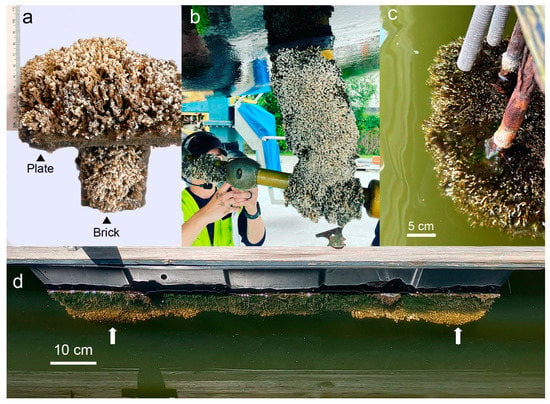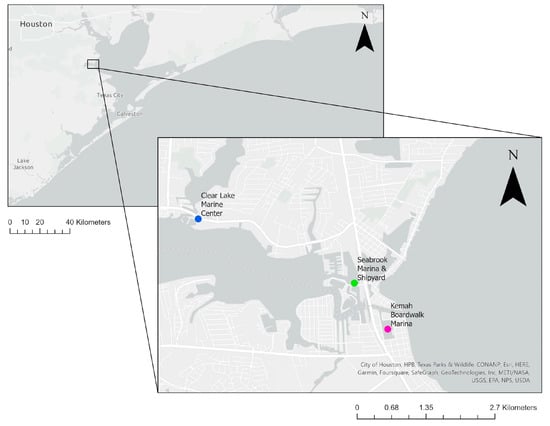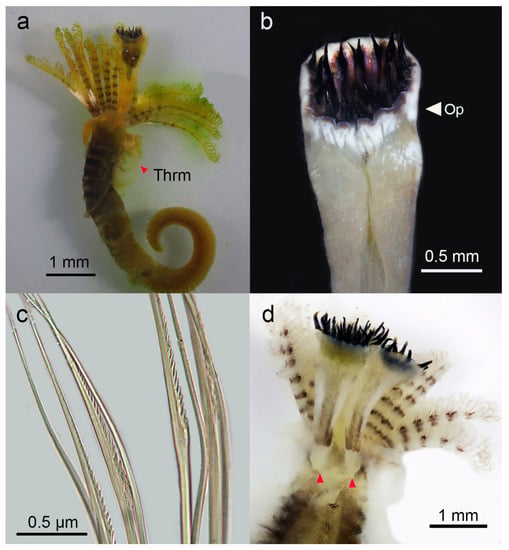Abstract
Herein, we report the recent proliferation of the non-native serpulid worm Ficopomatus enigmaticus in parts of Galveston Bay, Texas. Reef-like aggregations were first recovered from a settlement plate and a submerged brick at the Kemah Boardwalk Marina on 4 May 2023. By 20 May, similar growths were reported to us by the Kemah Boardwalk Marina on floating docks, boat hulls, propellers, and rudders. On June 8, nearby marinas remained unaffected. We confirmed the worms’ species identities by noting their diagnostic characteristics.
Keywords:
biofouling; invasive; estuary; suspension feeder; reef building; Gulf of Mexico; ecosystem engineer Estuaries, especially those with major ports and heavy shipping traffic, are prone to invasion by non-native species [,,]. Galveston Bay (GB), Texas, is a subtropical estuary located on the northern coast of the Gulf of Mexico. GB is home to three major ports: Houston, Galveston, and Texas City. The intense shipping traffic provides opportunities for the introduction of non-native species into the GB system through either ballast water or hull-fouling communities []. Another possible pathway for species introduction is aquaculture, which is of regional importance because commercial oyster farming only began in Texas in 2020 after a dramatic decline in natural oyster reefs that started in 2007 []. Non-native species are poorly documented in GB compared to other major shipping hubs in the US, which is partly due to a lack of baseline information about pre-industrial biological communities.
Herein, we report on the recent proliferation of the serpulid annelid Ficopomatus enigmaticus (Fauvel, 1923) in a part of GB. On 4 May 2023, we recovered a large aggregation of F. enigmaticus from a settlement panel at the Kemah Boardwalk Marina (KBM) and on a submerged brick, both of which were almost completely covered (Figure 1a). On 20 May 2023, we were contacted by the Marina General Manager at KBM, who reported large accumulations on floating docks, hulls, rudders, and the propellers of recreational boats (Figure 1b). On 8 June 2023, we inspected the Kemah Boardwalk Marina as well as the nearby Clear Lake Marine Center and the Seabrook Marina and Shipyard (Figure 2). Large aggregations of F. enigmaticus were only present at the KBM (Figure 1c,d). At the other locations, we only detected small numbers of individual tubes, although the environmental conditions were similar (Table 1). Although we previously recovered two additional Ficopomatus species (F. uschakovi and F. miamiensis) from settlement plates at the same location, we did not detect these species in the large aggregations. We have not yet identified any environmental conditions that might have triggered the sudden localized proliferation of F. enigmaticus.

Figure 1.
Massive aggregations of Ficopomatus enigmaticus in Kemah, Galveston Bay, Texas. (a) Colonization plate and brick recovered from Kemah Boardwalk Marina covered in tubes; (b) boat propeller; (c) patch of F. engimaticus underneath a floating dock; (d) floating dock with F. enigmaticus (arrows point to the clusters). (b) was provided by the General Manager of Kemah Boardwalk Marina.

Figure 2.
Map of the studied shipyard and marinas in Galveston Bay, Texas, USA.

Table 1.
Water environmental conditions in the study locations. Measurements were taken at a depth of 1 m from the surface on 8 June 2023 using a YSI water quality instrument (Pro2030, Yellow Springs Instruments, Yellow Springs, OH, USA).
Ficopomatus enigmaticus was first reported in Galveston Bay in 2003 []. In 2017, it was observed on settlement plates, together with the native F. miamiensis and the non-native F. uschakovi []. Between 2019 and 2022, it was regularly detected on settlement plates deployed seasonally in GB []. The worms were present at mesohaline stations (6–12 ppt in the northern and central sites of GB and ~18 ppt in West Bay), but their numbers remained low []. The first reports of F. enigmaticus in the northern Gulf of Mexico emerged in the early 1950s in reference to Corpus Christi Bay [] and Aransas Bay []. Ficopomatus enigmaticus has also been reported further east in Mississippi (1997) and Tampa Bay (2002) []. It does not seem to occur in significant numbers or form reef-like structures in any of these locations.
Ficopomatus enigmaticus is known as as a worldwide invader in many temperate to subtropical coastal areas with brackish conditions []. Individual worms are generally 10–15 mm long, but worms as large as 39 mm have been reported []. Like other serpulid worms [], F. enigmaticus secretes and inhabits calcareous tubes that exceed its body length by a factor of 2–3 and are 1–2 mm wide, possessing a flared anterior end []. Individual tubes can cluster together in reef-like structures that can be up to 7 m in diameter and grow to a height of 0.5 m []. Clusters can converge, with new recruitment over old aggregates, sometimes forming continuous reef-like structures up to 3 m thick []. We identified F. enigmaticus by referring to its diagnostic characteristics reported by Bastida-Zavala et al. []: a fig-shaped operculum (Figure 3a) with a horny plate covered with inwardly pointing dark brown to black spines (Figure 3b); well-developed thoracic membranes that are not fused dorsally (Figure 3a); and coarsely serrated chaetae in the collar (Figure 3c). Among the examined specimens, we found an individual with two opercula (Figure 3d), which were inserted on the right and left lobes, respectively. According to Bastida-Zavala et al. [], only the genera Apomatus and Filogranna, and sometimes Hydroides, present duplicate opercula. We did not find previous reports of this phenomenon in previous studies; therefore, this is the first evidence of a specimen of F. enigmaticus with duplicate operculum.

Figure 3.
Ficopomatus enigmaticus (a) Complete body in lateral view (the red triangle indicates the thoracic membrane); (b) operculum in dorsal view; (c) coarsely serrated chaetae in the collar; (d) specimen of F. enigmaticus with duplicate operculum in dorsal view (the red triangles indicate the insertion points in the body). Abbreviations: operculum (Op); thoracic membrane (Thrm).
The native range of F. enigmaticus is unclear. Although the species is often referred to as the “Australian tubeworm”, Australia might not have been its geographic origin []. Massive invasions have occurred in the Mediterranean and Black Seas [,,], the Baltic Sea [], the North American west coast [,], the southwest Atlantic [], New Zealand [], and South Africa []. Ficopomatus enigmaticus has been reported in numerous other locations but does not always engage in reef building. Where it does form reefs, these reefs can have significant ecological and economic impacts. As an efficient suspension feeder, F. enigmaticus competes with other filter-feeding organisms over phytoplankton []. As an ecosystem engineer, it generally increases biodiversity by altering the community composition of the benthic fauna, including facilitating the establishment of other non-native species [,,,]. Another concern is the fouling of other organisms (e.g., oysters), which could alter their hydrodynamic properties and feeding efficiency. Tubeworm aggregates on artificial structures, such as boats, pilings, buoys, and bulkheads, can precipitate significant clean-up costs and pose a safety risk to swimmers. Tubeworm aggregations can also block pipes and sluice gates [,,].
Whether the recent proliferation of F. enigmaticus in Kemah, Texas, will expand to other parts of GB or whether the worms will die back with seasonal weather changes remains to be seen. We are currently raising awareness among boaters and shipyard and marina operators to alert us of new occurrences. Genetic and ecological studies of the reef-building worms, and individual worms originating from different locations collected throughout all seasons in GB, are currently underway.
Author Contributions
Conceptualization, V.F.-R. and A.S.; methodology, V.F.-R. and A.S.; resources, L.J. and A.S.; data curation, V.F.-R.; writing—original draft preparation, A.S.; writing—review and editing, V.F.-R., L.J. and A.S.; visualization, V.F.-R.; supervision, A.S.; project administration, A.S. and L.J.; funding acquisition, A.S. and L.J. All authors have read and agreed to the published version of the manuscript.
Funding
This research was funded by a “Mentorship-through-Collaboration” grant (Marine Biology Department, Texas A&M University at Galveston) given to A.S. and L.J.
Data Availability Statement
All relevant data are included in the body of this manuscript.
Acknowledgments
We acknowledge the assistance of Brad Grace, General Manager at Kemah Boardwalk Marina, and the cooperation of the management of the Clear Lake Marine Center and the Seabrook Marina and Shipyard. We also thank Marissa J. Palmer for her assistance with the map.
Conflicts of Interest
The authors declare no conflict of interest.
References
- Williams, S.L.; Grosholz, E.D. The invasive species challenge in estuarine and coastal environments: Marrying management and Science. Estuaries Coasts 2008, 31, 3–20. [Google Scholar] [CrossRef]
- Bailey, S.A.; Brown, L.; Campbell, M.L.; Canning-Clode, J.; Carlton, J.T.; Castro, N.; Chainho, P.; Chan, F.T.; Creed, J.C.; Curd, A.; et al. Trends in the detection of aquatic non-indigenous species across global marine, estuarine and freshwater ecosystems: A 50-year perspective. Divers. Distrib. 2020, 26, 1780–1797. [Google Scholar] [CrossRef]
- Nehring, S. Four arguments why so many alien species settle into estuaries, with special reference to the German river Elbe. Helgol. Mar. Res. 2006, 60, 127–134. [Google Scholar] [CrossRef]
- Steichen, J.L.; Schulze, A.; Brinkmeyer, R.; Quigg, A. All aboard! A biological survey of ballast water onboard vessels spanning the North Atlantic Ocean. Mar. Pollut. Bull. 2014, 87, 201–210. [Google Scholar] [CrossRef]
- Du, J.; Park, K.; Jensen, C.; Dellapenna, T.M.; Zhang, W.G.; Shi, Y. Massive oyster kill in Galveston Bay caused by prolonged low-salinity exposure after Hurricane Harvey. Sci. Total Environ. 2021, 774, 145132. [Google Scholar] [CrossRef]
- Keppel, E. National Exotic Marine and Estuarine Species Information System. Ficopomatis enigmaticus. 2018. Available online: http://invasions.si.edu/nemesis (accessed on 17 June 2023).
- Bastida-Zavala, J.R.; McCann, L.; Keppel, E.; Ruiz, G.M. The fouling serpulids (Polychaeta: Serpulidae) from United States coastal waters: An overview. Eur. J. Taxon. 2017, 344, 1–76. [Google Scholar] [CrossRef]
- Jurgens, L.J.; Ciesielski, M.; Agrawal, A.; Hubbard, E. Low salinity weakens predator effects on community assembly in a sub-tropical estuary. Estuaries Coasts 2022, 45, 2070–2081. [Google Scholar] [CrossRef]
- Hartman, O. Fouling serpulid worms, new to the Gulf of Mexico. Tex. J. Sci. 1952, 4, 63–64. [Google Scholar]
- ten Hove, H.A.; Weerdenburg, J.C.A. A generic revision of the brackish-water serpulid Ficopomatus Southern 1921 (Polychaeta: Serpulinae), including Mercierella Fauvel 1923, Sphaeropomatus Treadwell 1934, Mercierellopsis Rioja 1945 and Neopomatus Pillai 1960. Biol. Bull. 1978, 154, 96–120. [Google Scholar] [CrossRef]
- Kopiy, V.G.; Zaitseva, O.V.; Petrov, S.A. Biological characteristics of the polychaete Ficopomatus enigmaticus (Fauvel, 1923) from mass settlements in the coastal water area of the Kerch Strait (Black Sea). Russ. J. Biol. Invasions 2022, 13, 219–231. [Google Scholar] [CrossRef]
- Schwindt, E.; Bortolus, A.; Iribarne, O.O. Invasion of a reef-builder polychaete: Direct and indirect impacts on the native benthic community structure. Biol. Invasions 2001, 3, 137–149. [Google Scholar] [CrossRef]
- Fornós, J.J.; Forteza, V.; Martínez-Taberner, A. Modern polychaete reefs in Western Mediterranean lagoons: Ficopomatus enigmaticus (Fauvel) in the Albufera of Menorca, Balearic Islands. Palaeogeogr. Palaeoclimatol. Palaeoecol. 1997, 128, 175–186. [Google Scholar] [CrossRef]
- Bastida-Zavala, R.; Sanchez-Ovando, J.P. Serpulidae Rafinesque,1815. In Anélidos Marinos de México y América Tropical, 2nd ed.; de León-González, J.A., Bastida-Zavala, R., Carrera-Parra, L.F., García-Garza, M.E., Sergio Ignacio, S.V., Solís-Weiss, V., Tovar-Hernández, M.A., Eds.; Universidad Autónoma de Nuevo León: Monterrey, Mexico, 2021. [Google Scholar]
- Styan, C.A.; McCluskey, C.F.; Sun, Y.; Kupriyanova, E.K. Cryptic sympatric species across the Australian range of the global estuarine invader Ficopomatus enigmaticus (Fauvel, 1923) (Serpulidae, Annelida). Aquat. Invasions 2017, 12, 53–65. [Google Scholar] [CrossRef]
- Bianchi, C.; Morri, C. The battle is not to the strong: Serpulid reefs in the lagoon of Orbetello (Tuscany, Italy). Estuar. Coast. Shelf Sci. 2001, 53, 215–220. [Google Scholar] [CrossRef]
- Bianchi, C.N.; Morri, C. Ficopomatus ‘Reefs’ in the Po River Delta (Northern Adriatic): Their constructional dynamics, biology, and influences on the brackish-water biota. Mar. Ecol. 1996, 17, 51–56. [Google Scholar] [CrossRef]
- Hille, S.; Kunz, F.; Markfort, G.; Ritzenhofen, L.; Zettler, M.L. First record of mass occurrence of the tubeworm Ficopomatus enigmaticus (Fauvel, 1923) (Serpulidae: Polychaeta) in coastal waters of the Baltic Sea. BioInvasions Rec. 2021, 10, 859–868. [Google Scholar] [CrossRef]
- Pernet, B.; Barton, M.; Fitzhugh, K.; Harris, L.H.; Lizárraga, D.; Ohl, R. Establishment of the reef-forming tubeworm Ficopomatus enigmaticus (Fauvel, 1923) (Annelida: Serpulidae) in southern California. BioInvasions Rec. 2016, 5, 13–19. [Google Scholar] [CrossRef]
- Yee, A.; Mackie, J.; Pernet, B. The distribution and unexpected genetic diversity of the non-indigenous annelid Ficopomatus enigmaticus in California. Aquat. Invasions. 2019, 14, 250–266. [Google Scholar] [CrossRef]
- Schwindt, E.; Iribarne, O.O. Reef of Ficopomatus enigmaticus (Polychaeta; Serpulidae) in the Mar Chiquita coastal lagoon, Argentina. Bolletí Soc. D’història Nat. Balear. 1998, 41, 35–40. [Google Scholar]
- Read, G.B.; Gordon, D.P. Adventive occurrence of the fouling serpulid Ficopomatus enigmaticus (Polychaeta) in New Zealand. N. Z. J. Mar. Freshw. Res. 1991, 25, 269–273. [Google Scholar] [CrossRef]
- Bezuidenhout, M.; Robinson, T.B. Abundance and distribution of the invasive polychaete Ficopomatus enigmaticus in three South African estuaries. Reg. Stud. Mar. Sci. 2020, 39, 101405. [Google Scholar] [CrossRef]
- Bruschetti, M.; Luppi, T.; Fanjul, E.; Rosenthal, A.; Iribarne, O. Grazing effect of the invasive reef-forming polychaete Ficopomatus enigmaticus (Fauvel) on phytoplankton biomass in a SW Atlantic coastal lagoon. J. Exp. Mar. Biol. Ecol. 2008, 354, 212–219. [Google Scholar] [CrossRef]
- Heiman, K.W.; Micheli, F. Non-native ecosystem engineer alters estuarine communities. Integr. Comp. Biol. 2010, 50, 226–236. [Google Scholar] [CrossRef]
- Heiman, K.W.; Vidargas, N.; Micheli, F. Non-native habitat as home for non-native species: Comparison of communities associated with invasive tubeworm and native oyster reefs. Aquat. Biol. 2008, 2, 47–56. [Google Scholar] [CrossRef]
- Martinez, L.E.; Bazterrica, M.C.; Hidalgo, F.J. Influence of complexity and habitat heterogeneity on macrofaunal assemblages provided by an invasive ecosystem engineer in Mar Chiquita coastal lagoon. Estuar. Coast. Shelf Sci. 2020, 246, 107038. [Google Scholar] [CrossRef]
- McQuaid, K.A.; Griffiths, C.L. Alien reef-building polychaete drives long-term changes in invertebrate biomass and diversity in a small, urban estuary. Estuar. Coast. Shelf Sci. 2014, 138, 101–106. [Google Scholar] [CrossRef]
- Dittmann, S.; Rolston, A.; Benger, S.N.; Kupriyanova, E.K. Habitat Requirements, Distribution and Colonisation of the Tubeworm Ficopomatus enigmaticus in the Lower Lakes and Coorong. In Report for the South Australian Murray-Darling Basin Natural Resources Management Board, Adelaide. 2009, p. 99. Available online: https://www.researchgate.net/publication/260981354_Habitat_requirements_distribution_and_colonisation_of_the_tubeworm_Ficopomatus_enigmaticus_in_the_Lower_Lakes_and_Coorong (accessed on 17 June 2023).
- Charles, M.; Faillettaz, R.; Desroy, N.; Fournier, J.; Costil, K. Distribution, associated species and extent of biofouling “reefs” formed by the alien species Ficopomatus enigmaticus (Annelida, Polychaeta) in marinas. Estuar. Coast. Shelf Sci. 2018, 212, 164–175. [Google Scholar] [CrossRef]
- Probert, P.K. First record of the introduced fouling tubeworm Ficopomatus enigmaticus (Polychaeta: Serpulidae) in Hawke Bay, New Zealand. N. Z. J. Zool. 1993, 20, 35–36. [Google Scholar] [CrossRef]
Disclaimer/Publisher’s Note: The statements, opinions and data contained in all publications are solely those of the individual author(s) and contributor(s) and not of MDPI and/or the editor(s). MDPI and/or the editor(s) disclaim responsibility for any injury to people or property resulting from any ideas, methods, instructions or products referred to in the content. |
© 2023 by the authors. Licensee MDPI, Basel, Switzerland. This article is an open access article distributed under the terms and conditions of the Creative Commons Attribution (CC BY) license (https://creativecommons.org/licenses/by/4.0/).